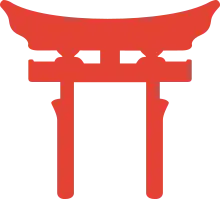| Part of a series on |
| Shinto |
|---|
 |
Kunitsukami (国つ神,[1] 国津神[2]) are the kami of the land[3] and live in tsuchi (earth).[4]
They were contrasted from the Amatsukami,[1] although modern Shinto no longer makes the distinction between Amatsukami and Kunitsukami.[5] According to Yijiang Zhong the distinction was made by the writers of the Nihon Shoki and the Kojiki to formulate a political discourse.[6]
Kunitsukami were often presented as tutelary deities. They were also associated with geographical areas along with their inhabitants. Non-royal families also viewed them as their ancestors.[7] They also were considered personifications of the land.[8]
According to Ernest Mason Satow and Karl Florenz, kunitsukami might have been deified chiefs who migrated to Japan.[9]
The Three Pioneer Kami (開拓三神, Kaitaku Sanjin) Ōkunitama, Ōkuninushi, and Sukunahikona used in Japanese colonial shrines. [10]: 61 .[11]: 53–54 They are all Kunitsukami or earthly kami representing the land.[11]: 53–54
Ogasawara Shozo proposed a system justifying Japanese Imperialism where Japanese people in the colonies were seen as Amatsukami and natives were seen as Kunitsukami,[12] however he was later censored as his position was considered too supportive of the rights of colonized peoples.[12]
Mythology
Many myths in the Nihon Shoki and the Kojiki are about the conflict between the Kunitsukami and the Amatsukami.[8]
List of kunitsukami
- Sovereign God
- Ōkuninushi no Gokojin
- Ajisukitakahikone, Shimo-shitsu-biki, Kotoshironushi, Takeminakata, Kizumata god, and Tora-kami god
- The gods who are the spouses of the lord of the great nation
- Suseri Vipassana, Yagami Vipassana, Numagawa Vipassana, Dokiri Vipassana, Kamiya Taten Vipassana, Tottorijin
- Others
- Ōyamatsumi, Susanoo-no-Mikoto, Kushinadahime, Sukunabikona, Ōmononushi, Kuebiko, Taka Kagyu, Watatsumi, Ōyamatsumi, Ukanomitama, Toshigami, Konohanasakuya-hime, Tamayori-hime, Toyotama-hime, Omizunu, Chikato no Kami, Moreya, Isetsuhiko, Takiribime, Ichikishimahime
See also
References
- 1 2 Klautau, Orion; Krämer, Hans Martin (2021-03-31). Buddhism and Modernity: Sources from Nineteenth-Century Japan. University of Hawaii Press. p. 130. ISBN 978-0-8248-8458-1.
- ↑ Goto, Akira (2020-11-19). Cultural Astronomy of the Japanese Archipelago: Exploring the Japanese Skyscape. Routledge. p. 28. ISBN 978-1-000-22109-1.
- ↑ Bocking, Brian (2005-09-30). A Popular Dictionary of Shinto. Routledge. ISBN 978-1-135-79738-6.
- ↑ Picken, Stuart D. B. (2010-12-28). Historical Dictionary of Shinto. Scarecrow Press. p. 38. ISBN 978-0-8108-7372-8.
- ↑ "kami | Definition, Translation, & Facts". Encyclopedia Britannica. Retrieved 2021-09-28.
- ↑ Zhong, Yijiang (2016-10-06). The Origin of Modern Shinto in Japan: The Vanquished Gods of Izumo. Bloomsbury Publishing. ISBN 978-1-4742-7109-7.
- ↑ Drott, Edward R. (2016-04-30). Buddhism and the Transformation of Old Age in Medieval Japan. University of Hawaii Press. p. 7. ISBN 978-0-8248-5150-7.
- 1 2 3 Ashkenazi, Michael (2003). Handbook of Japanese Mythology. ABC-CLIO. p. 141. ISBN 978-1-57607-467-1.
- ↑ Satow (2014-07-16). Ancient Japanese Rituals. Routledge. ISBN 978-1-317-79291-8.
- ↑ Shimizu, Karli; Rambelli, Fabio (2022-10-06). Overseas Shinto Shrines: Religion, Secularity and the Japanese Empire. London New York (N.Y.) Oxford: Bloomsbury Academic. ISBN 978-1-350-23498-7.
- 1 2 Kōji, Suga; 𨀉𠄈 (2010). "A Concept of "Overseas Shinto Shrines": A Pantheistic Attempt by Ogasawara Shōzō and Its Limitations". Japanese Journal of Religious Studies. 37 (1): 47–74. ISSN 0304-1042. JSTOR 27822899.
- 1 2 Kōji, Suga; 𨀉𠄈 (2010). "A Concept of "Overseas Shinto Shrines": A Pantheistic Attempt by Ogasawara Shōzō and Its Limitations". Japanese Journal of Religious Studies. 37 (1): 47–74. ISSN 0304-1042.
- ↑ Narayanan, Vasudha (2005). Eastern Religions: Origins, Beliefs, Practices, Holy Texts, Sacred Places. Oxford University Press. pp. 440–441. ISBN 978-0-19-522191-6.
- 1 2 Drott, Edward R. (2016-04-30). Buddhism and the Transformation of Old Age in Medieval Japan. University of Hawaii Press. p. 8. ISBN 978-0-8248-5150-7.
- ↑ Picken, Stuart D. B. (2010-12-28). Historical Dictionary of Shinto. Scarecrow Press. p. 76. ISBN 978-0-8108-7372-8.
External links
 Media related to Kunitsukami at Wikimedia Commons
Media related to Kunitsukami at Wikimedia Commons